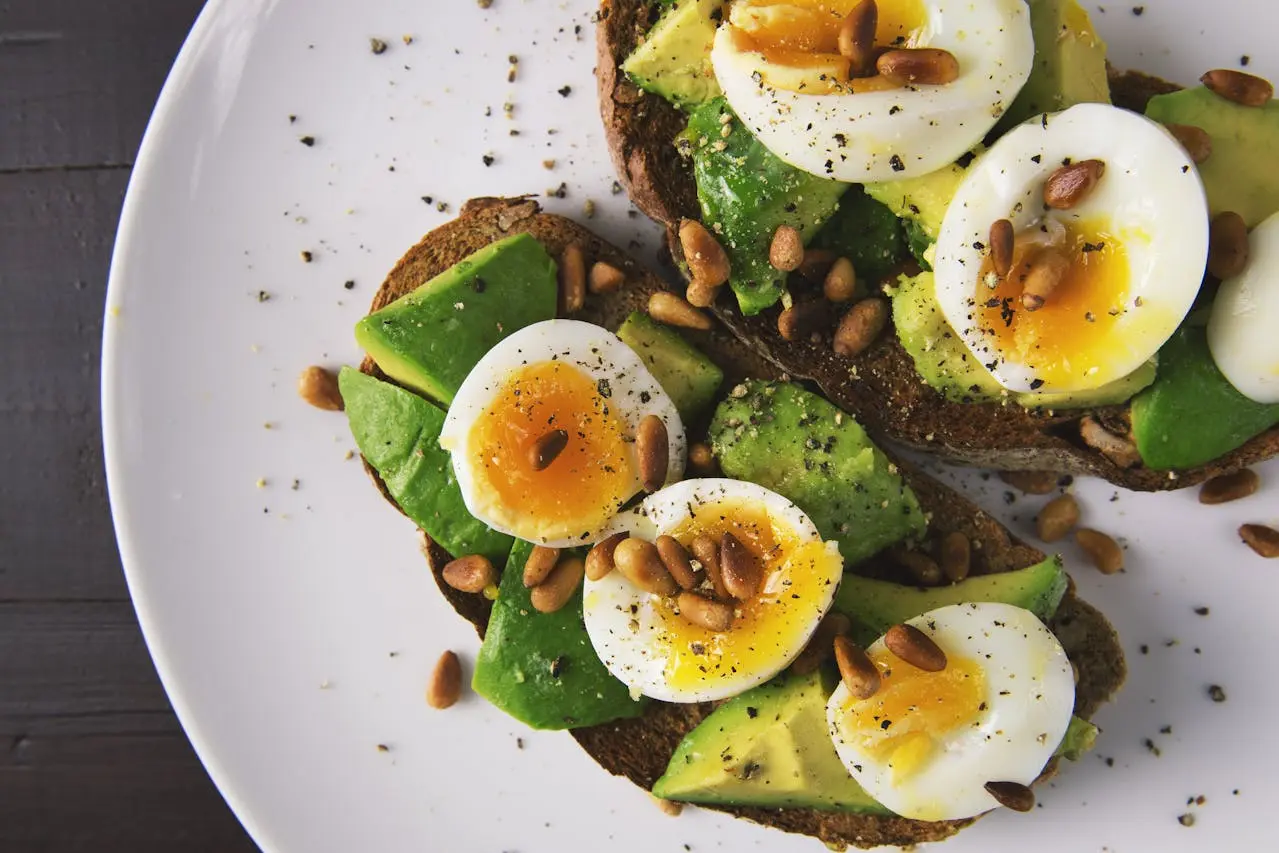
It’s time to make peace with your plate – and yourself
Can we talk about something that’s probably been on your mind way too much lately? Your relationship with food. You know what I mean – that constant mental chatter about what you should or shouldn’t eat, the guilt after enjoying a slice of cake, or that feeling like you’re either “on” or “off” with your eating.
What if I told you there’s a completely different way to approach food that doesn’t involve restriction, shame, or complicated rules? It’s called mindful eating, and it’s not another diet – it’s actually the opposite. It’s about coming home to yourself and learning to trust your body again.
What Mindful Eating Really Means (And What It’s Not)
Before we dive in, let’s clear something up. Mindful eating isn’t about:
- Eating perfectly all the time
- Never enjoying “indulgent” foods
- Analyzing every bite like a science experiment
- Adding more stress to your life
Instead, mindful eating is simply about being present with your food and honoring what your body actually needs. It’s about eating with awareness instead of on autopilot. And here’s the beautiful thing – when you start eating mindfully, you naturally begin to feel better in your body without having to force anything.
Why Your Current Relationship with Food Might Feel Complicated

Let’s be honest – most of us didn’t learn healthy eating habits growing up. Maybe you were told to clean your plate, or maybe certain foods were labeled as “bad.” Perhaps you’ve tried countless diets that left you feeling like you can’t trust yourself around food.
You’re not broken, honey. You just learned some patterns that aren’t serving you anymore. And the incredible news? You can absolutely learn new ones.
| Common Food Struggles | What’s Really Happening | How Mindful Eating Helps |
|---|---|---|
| Emotional eating | Using food to cope with feelings | Learn to recognize true hunger vs emotional needs |
| All-or-nothing thinking | Foods are either “good” or “bad” | Develop a balanced, flexible approach |
| Eating too fast | Not registering fullness cues | Slow down and tune into your body |
| Guilt and shame | Judging food choices harshly | Practice self-compassion and neutrality |
| Ignoring hunger | Not eating enough or skipping meals | Honor your body’s actual needs |
The 10 Practices That Will Change Everything
Ready to transform your relationship with food? These aren’t rules to follow perfectly – they’re gentle practices to experiment with. Pick one or two that resonate with you and start there.
Practice 1: The Sacred Pause Before You Eat
This is the foundation of everything else. Before you take your first bite, pause for just 10 seconds. That’s it. Just pause and breathe.
How to do it:
- Sit down with your food (yes, even for snacks when possible)
- Take three deep breaths
- Look at your food with curiosity instead of judgment
- Ask yourself: “How hungry am I right now?” (1-10 scale)
This simple pause helps you shift from autopilot eating to conscious choice-making. You might discover you’re not actually that hungry, or maybe you realize you need something completely different than what’s on your plate.
Practice 2: Eat With Your Non-Dominant Hand
I know this sounds weird, but stick with me! Eating with your non-dominant hand automatically slows you down and makes you more aware of each bite.
Why this works:
- Forces you to slow down naturally
- Breaks unconscious eating patterns
- Makes you more present with your food
- Helps you notice flavors and textures you usually miss
Try this for just one meal a day, or even just the first few bites. You’ll be amazed at how much more you actually taste your food.
Practice 3: The Three-Bite Rule

Here’s a game-changer: pay extra attention to your first three bites of any meal or snack. These bites tell you everything you need to know about whether this food is satisfying you.
| Bite | What to Notice | Questions to Ask |
|---|---|---|
| First Bite | Initial taste and satisfaction | Does this taste as good as I expected? |
| Second Bite | Texture, temperature, enjoyment | Am I still excited about this food? |
| Third Bite | Overall satisfaction level | Is this hitting the spot or am I just eating out of habit? |
If the first three bites aren’t satisfying, it’s totally okay to choose something else! This isn’t about restriction – it’s about honoring what actually brings you pleasure.
Practice 4: Put Your Fork Down Between Bites
This simple habit is pure magic for slowing down and connecting with your fullness cues. Most of us shovel food in without breathing, which means we miss the gentle signals our body sends about satisfaction.
The technique:
- Take a bite
- Put your fork (or food) down completely
- Chew slowly and swallow
- Take a breath
- Check in with your hunger level
- Pick up your fork for the next bite
This practice alone can transform how much you enjoy your meals and how satisfied you feel afterward.
Practice 5: The Hunger and Fullness Scale
Your body is constantly sending you information about what it needs – you just need to learn how to listen. The hunger and fullness scale helps you tune back into these natural signals.
| Scale | Hunger Level | How You Feel | What to Do |
|---|---|---|---|
| 1-2 | Overly hungry | Shaky, irritable, can’t think clearly | Eat something nourishing soon |
| 3-4 | Moderately hungry | Stomach growling, thinking about food | Perfect time for a meal |
| 5-6 | Neutral | Comfortable, not thinking about food | Check if you’re eating out of habit |
| 7-8 | Comfortably satisfied | Pleasant fullness, energized | Great place to stop eating |
| 9-10 | Overfull | Uncomfortable, sluggish, regretful | Next time, stop at 7-8 |
Start checking in with this scale before, during, and after meals. There’s no perfect number – it’s just information to help you understand your patterns.
Practice 6: The Five Senses Check-In
When’s the last time you really, truly tasted your food? This practice brings you fully into the present moment with your meal.
Before you eat, notice:
- Sight: Colors, textures, how the food looks on your plate
- Smell: Take a moment to actually smell your food
- Sound: Does it crunch, sizzle, or make other sounds?
While eating, pay attention to:
- Taste: Sweet, salty, bitter, sour, umami flavors
- Touch: Temperature, texture, how it feels in your mouth
This isn’t about being precious with every single bite – it’s about occasionally dropping into full presence with your food. Even doing this once during a meal can be transformative.
Practice 7: Ditch the Distractions
I get it – we’re all busy. But eating while scrolling your phone, watching TV, or working at your computer disconnects you from your body’s signals. You end up eating more than you need because you never registered the meal in the first place.
Creating a mindful eating environment:
- Put devices away or at least face-down
- Sit at a table when possible (not standing at the counter)
- If you must multitask, choose activities that don’t require intense focus
- Consider making one meal per day completely distraction-free
Start small – maybe just breakfast without your phone, or dinner without the TV. Notice how different it feels to actually be present with your food.
Practice 8: Honor Your Cravings (Yes, Really!)
This might be the hardest one for you if you’re used to labeling foods as “good” or “bad.” But here’s the thing – when you consistently deny your cravings, they often come back stronger and lead to that out-of-control feeling around certain foods.
The mindful approach to cravings:
- Acknowledge the craving without judgment
- Ask yourself: Am I actually hungry, or do I need something else?
- If you’re hungry: Have some of what you’re craving mindfully
- If you’re not hungry: Explore what you might actually need (rest, connection, stress relief)
- Either way: Be kind to yourself about whatever you choose
When you give yourself permission to eat what you’re craving, you often find you need much less of it to feel satisfied.
Practice 9: Practice Food Neutrality

This is about removing the moral judgment from food choices. Food is just food – it’s not good or bad, and eating it doesn’t make you good or bad either.
| Instead of This | Try This |
|---|---|
| “I was so bad today – I ate pizza” | “I chose to eat pizza and it was satisfying” |
| “I need to be good and eat salad” | “I’m choosing salad because it sounds good right now” |
| “I can’t control myself around cookies” | “I’m learning to trust myself with all foods” |
| “I cheated on my diet” | “I ate something I enjoyed” |
This shift in language might feel strange at first, but it’s incredibly freeing. When you remove the drama from food choices, you can make decisions based on what actually serves you.
Practice 10: The Gentle Self-Compassion Practice
Here’s the truth: you’re going to have days when you eat mindlessly, when you’re stressed and reach for comfort food, or when you eat past fullness. That’s completely normal and human.
When this happens:
- Notice without judgment (“Oh, I ate mindlessly tonight”)
- Remind yourself that this doesn’t define you
- Ask what you might need right now (rest, comfort, support)
- Recommit to gentle awareness for your next meal
Self-compassion isn’t self-indulgence – it’s actually what allows you to make changes that stick. When you’re harsh with yourself, you’re more likely to give up entirely.
Your 30-Day Mindful Eating Journey
Feeling ready to start but not sure how? Here’s a gentle progression that won’t overwhelm you:
Week 1: Foundation Building
Days 1-3: Practice the sacred pause before meals Days 4-7: Add the hunger and fullness scale check-ins
Week 2: Slowing Down
Days 8-10: Try eating with your non-dominant hand Days 11-14: Practice putting your fork down between bites
Week 3: Deeper Awareness
Days 15-17: Focus on the three-bite rule Days 18-21: Experiment with the five senses check-in
Week 4: Integration and Self-Compassion
Days 22-24: Work on ditching distractions during one meal daily Days 25-28: Practice food neutrality language Days 29-30: Focus on self-compassion and celebrating your progress
Remember, you don’t have to do all of these practices every day. Pick one or two that feel doable and focus on those until they become natural.
Troubleshooting Common Challenges
“I keep forgetting to eat mindfully” This is so normal! Try linking mindful eating to something you already do consistently. Maybe you always drink water before meals – that can be your mindful eating cue.
“I feel silly slowing down this much” Start small – maybe just the first three bites of one meal. You don’t have to meditate over every morsel. Even small moments of awareness make a difference.
“My family thinks I’m being weird about food” You don’t have to announce what you’re doing. Mindful eating can be very subtle. If asked, you can simply say you’re trying to enjoy your food more.
“I still overeat sometimes” Of course you do! This is a practice, not perfection. Every time you notice you’ve overeaten, that’s actually a victory – it means your awareness is growing.
“I don’t have time for all this” Mindful eating doesn’t take more time – it just requires shifting your attention. You can eat mindfully in 5 minutes or 50 minutes.
The Science Behind Why This Works
You don’t need to understand the science to benefit from mindful eating, but it might help to know that this isn’t just “woo-woo” stuff – it’s backed by real research.
| What Happens | Why It Matters | The Result |
|---|---|---|
| Improved digestion | Eating slowly aids stomach acid production | Less bloating, better nutrient absorption |
| Better hunger/fullness recognition | Slowing down lets hormones signal the brain | Natural portion control without restriction |
| Reduced stress eating | Awareness helps distinguish emotions from hunger | Less impulsive food choices |
| Increased satisfaction | Paying attention enhances flavor perception | Feel satisfied with less food |
| Improved relationship with food | Removes guilt and shame from eating | More peace and less food obsession |
Making It Work in Real Life

Let’s be practical here. You’re not going to eat every meal in complete silence, savoring each bite like it’s your last. Here’s how to make mindful eating work with your actual life:
At work: Take the first three bites of your lunch without looking at your computer screen.
With kids: Model mindful eating by occasionally commenting on your food (“Mm, this apple is really crunchy!”).
At restaurants: Check in with your hunger level when the food arrives and again halfway through.
During busy times: Even just taking three deep breaths before eating counts as mindful eating.
When stressed: This is actually when mindful eating is most helpful – it can be a mini-meditation that grounds you.
What Changes You Might Notice
Everyone’s journey is different, but here are some shifts women often experience when they start eating more mindfully:
Week 1-2:
- More awareness of eating patterns
- Noticing when you eat on autopilot
- Beginning to taste food more fully
Week 3-4:
- Better recognition of hunger and fullness
- Less desire to eat when not hungry
- Increased satisfaction from meals
Month 2-3:
- Reduced anxiety around food choices
- More trust in your body’s signals
- Less guilt and shame about eating
Long-term:
- Natural weight regulation (if that was a concern)
- Improved digestion and energy
- Food becomes fuel and pleasure, not stress
Remember, these changes happen gradually and gently. Trust the process and be patient with yourself.
Beyond the Plate: How Mindful Eating Changes Everything
Here’s what I love most about mindful eating – it’s not really about food at all. It’s about learning to be present, trust yourself, and practice self-compassion. These skills spill over into every area of your life.
When you learn to pause before eating, you also learn to pause before reacting in difficult conversations. When you practice self-compassion about food choices, you become kinder to yourself in other areas too. When you learn to trust your body’s hunger signals, you also learn to trust your intuition in other decisions.
Mindful eating is really mindful living, starting with something you do multiple times every day.
Your Mindful Eating Toolkit
Here are some tools and resources to support your journey:
Free Apps:
- Insight Timer (for eating meditation)
- Headspace (has eating mindfully sessions)
- Calm (includes mindful eating content)
Journal Prompts:
- How hungry am I before this meal?
- What am I really craving right now?
- How did that food make me feel?
- What emotions am I bringing to this meal?
Simple Reminders:
- Set phone alarms for hunger check-ins
- Put a small note on your fridge
- Use a special plate or utensil as a mindfulness cue
- Practice gratitude for your food before eating
The Ripple Effect of Food Peace
When you make peace with food, something beautiful happens. You free up all that mental energy you were spending on food obsession, guilt, and restriction. You can use that energy for things that actually matter to you – your relationships, your goals, your joy.
You also become a role model for the people around you, especially if you have children. When they see you eating with pleasure and without guilt, you give them permission to have a healthy relationship with food too.
Your Next Bite
Beautiful soul, you have everything you need to start this journey right now. You don’t need to wait until Monday, or until you have the “perfect” plan, or until you feel more motivated.
Your next meal is an opportunity to practice. Your next snack is a chance to pause and breathe. Your next bite is a moment to be present.
Start wherever you are, with whatever you have. Choose one practice that feels most doable for you today. Maybe it’s just putting your phone down during lunch, or taking three breaths before you eat dinner.
The goal isn’t to be perfect – it’s to be aware. It’s to slowly, gently, lovingly come back into relationship with your body and your food. You deserve to eat with peace and pleasure. You deserve to trust yourself. You deserve to be free from food anxiety.
And honey? You absolutely have what it takes to get there.
Which practice are you going to try first? Remember, this is a journey of self-discovery, not a test you can fail. Every moment of awareness is a victory. I’m cheering you on every step of the way!





Pingback: 15 Quiet Luxury Habits That Cost Nothing